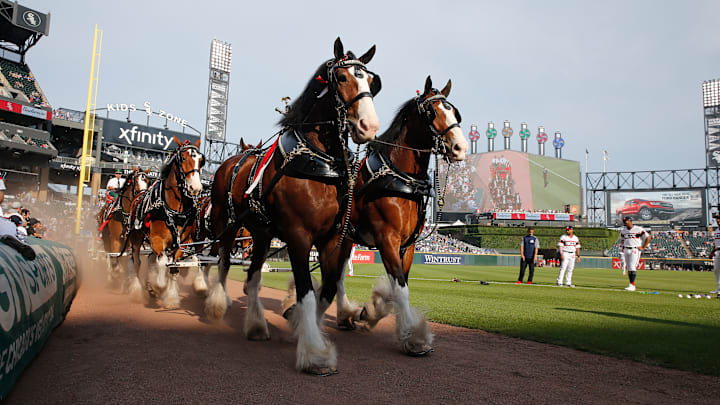April 1933 was a great month for beer enthusiasts. President Franklin D. Roosevelt had repealed the Volstead Act, putting an end to the Prohibition of the beverage. Two brothers, August A. Busch Jr and Adolphus Busch III, came up with an unusual way to celebrate the occasion: They gave their father, August A. Busch Sr.—the CEO of the brewing company Anheuser-Busch—a beer wagon, complete with half a dozen Clydesdales to pull it.
A Story of Beer and Beast
The company quickly realized the horses could be a powerful marketing tool. They sent a different six-horse hitch to haul a case of beer to the governor of New York, who had fought to end Prohibition. The Clydesdales became the stars of a promotional tour across New England and the Mid-Atlantic, during which they delivered a batch of Budweiser to FDR. Crowds began to gather to watch the horses at their stops throughout the journey. Soon, the breed—previously known for being hard-working farm animals in the Clydesdale area of Scotland—became associated with the American beer brand.

Anheuser Busch began breeding their own Clydesdales in 1953. Their program—which continues today—allowed the breed to prosper in North America; the company currently owns more than 200 Clydesdales boarded in stables throughout the country, and their main breeding facility houses around 70 horses.
Not every Clydesdale is cut out for the job; in fact, being a Budweiser Clydesdale horse comes with a strict set of requirements. To be considered, the horse must be a gelding (a neutered male), be at least 4 years old, stand at least 18 hands (6 feet) tall, and have a bay coat with a white blaze. Each Budweiser Clydesdale wears a hand-crafted harness that weighs 130 pounds. When paired with their iconic 3.5-ton red, white, and gold beer wagon, they truly make an unforgettable spectacle.
Continuing the tradition established in 1933, teams of Budweiser Clydesdales still travel throughout the United States and abroad, making hundreds of media appearances each year. They’re sent out in groups of 10 (eight to pull the eight-horse hitches the company currently uses, and two to serve as alternates), with a trusty Dalmatian in tow. The animals received the dogs as a mascot of their own in 1950, when a Dalmatian was introduced into the Budweiser Clydesdale clan to mark the opening of the Newark Brewery. (Historically, Dalmatians have played a protective role for horses, keeping fire wagons safe from other animals during transit and helping to keep the equines calm during potentially chaotic events.)
From Stable to Super Bowl Staple
Though many members of the Budweiser herd are on the road a lot, some of the horses have different marketing jobs: They’re the ones trained to appear on television. For decades, the Clydesdales appeared in wholesome, feel-good holiday commercials, often trotting through the snow. The company’s decision to drop the horses from their 2014 holiday advertisements in an effort to appeal to younger audiences caused a bit of a stir; they’ve since made appearances in more recent years.
But the horses are best known for another event: In 1986, the Budweiser Clydesdales began starring in the company’s Super Bowl advertisements. The brand’s popular 1996 Super Bowl commercial, which featured the horses playing their own game of football, cemented their legacy as beloved members of the game’s roster of anticipated commercials.
The advertisements’ tones have changed throughout the years—some were lighthearted and playful, while others, like the one that aired during the 2002 Super Bowl and featured the Clydesdales bowing before the New York City skyline, have a more somber air. A few commercials have even focused more on their Dalmatian mascots than the horses themselves.
The Budweiser Clydesdale horses may be associated with the Super Bowl, but they haven’t appeared during every game. In 2021, for instance, the company pulled their advertisements for the first time in 37 years, opting to use the money instead to help spread COVID-19 vaccine awareness. The horses did, however, return for the 2022 Super Bowl.
The bay beasts are back again for the 2025 game: “Super Bowl LIX ‘First Delivery’” follows a determined foal’s quest to deliver a lost barrel of Budweiser.
Discover More Stories About Horses:
A version of this story originally ran in 2022; it has been updated for 2025.
